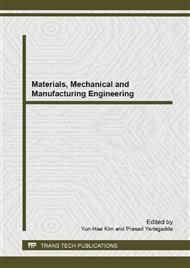p.27
p.31
p.35
p.39
p.43
p.52
p.57
p.61
p.70
Improve Efficiency of Organic Solar Cell by Adding Dispersed ZnO Nanoparticles
Abstract:
The poly (3-hexylthiophene) (P3HT) is a promising candidate material for using in polymer solar cells researches due to its good absorbance and stability. In this study, we present the electro-optical performance of organic polymer solar cells based on P3HT: [6,-phenyl-C61-butyric acid methyl ester (PCBM) with weight ratio of 1:1. We added ZnO nanoparticles into the blending of P3HT and PCBM to improve the performance of polymer solar cells. ZnO nanoparticles are very promising inorganic metal oxides for use in organic solar cells because of its low cost, nontoxicity, high reflectance and good electron transport properties. The morphology of polymer solar cell was improved due to the additional of ZnO nanoparticles. The effects of thermal annealing on the solar cell had been studied. The post-annealing shows significant improvement in the performance for solar cell. How to prevent ZnO nanoparticles to agglomerate is essential as they are added to the active layer of the solar cell. Well dispersed ZnO nanoparticles are obtained by using the methanol solvent. The best performances of the solar cell with short-circuit current density of 14.66 mW/cm2 and efficiency of 3.92% can be obtained after post-annealed with well being dispersed 1.3wt% ZnO nanoparticles in the active layer.
Info:
Periodical:
Pages:
43-51
Citation:
Online since:
November 2013
Authors:
Keywords:
Price:
Сopyright:
© 2014 Trans Tech Publications Ltd. All Rights Reserved
Share:
Citation:



